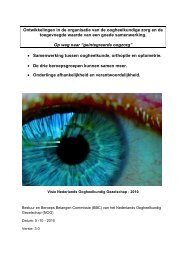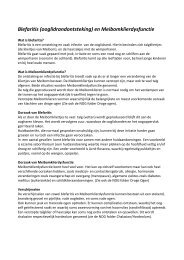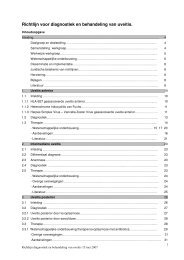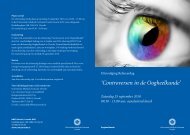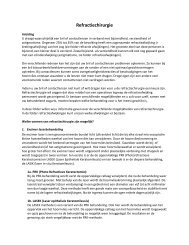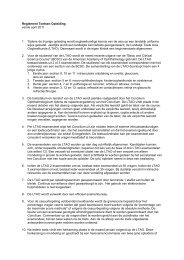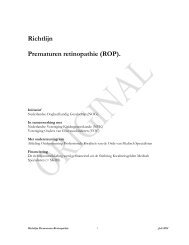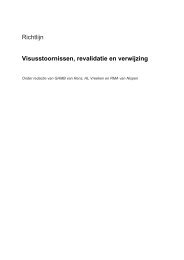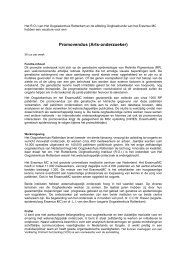terminology and guidelines for glaucoma ii - Kwaliteitskoepel
terminology and guidelines for glaucoma ii - Kwaliteitskoepel
terminology and guidelines for glaucoma ii - Kwaliteitskoepel
Create successful ePaper yourself
Turn your PDF publications into a flip-book with our unique Google optimized e-Paper software.
Systemic Risk factors <strong>for</strong> primary angle-closure 8,11<br />
• Female<br />
• Family history if primary angle-closure<br />
• Necessity of using sympathomimetics or sympatholytics<br />
• Race: Eskimo, Asians<br />
Primary angle-closure. Descriptions of Glaucoma types 12,13<br />
Primary angle-closure <strong>glaucoma</strong> is divided into 3 subtypes:<br />
• Acute Angle-Closure Glaucoma (AACG)<br />
• Intermittent Angle-Closure Glaucoma (IACG)<br />
• Chronic Angle-Closure Glaucoma (CACG)<br />
Etiology: iridotrabecular contact <strong>and</strong>/or adhesion<br />
Pathomechanism: decreased aqueous outflow due to TM occlusion<br />
Features: angle-closed at gonioscopy, without a discernible cause<br />
2.4.1.1 - Acute Angle-Closure Glaucoma (AACG)<br />
Etiology: circumferential iris apposition to the trabecular meshwork with rapid <strong>and</strong> excessive increase in intraocular<br />
pressure (IOP) that does not resolve spontaneously.<br />
Pathomechanism: see Ch. 2.4.1<br />
Features:<br />
Signs:<br />
IOP elevated often to 50-80 mm Hg<br />
Decreased visual acuity<br />
Corneal edema, initially mostly epithelial edema<br />
Shallow or flat peripheral anterior chamber<br />
Peripheral iris pushed <strong>for</strong>ward <strong>and</strong> in contact with Schwalbe’s line.<br />
Gonioscopy: angle-closure 360 degrees<br />
Pupil mid-dilated <strong>and</strong> reduced or no reactivity<br />
Venous congestion <strong>and</strong> ciliary injection<br />
Fundus: disc edema, with venous congestion <strong>and</strong> splinter hemorrhages, or the disc may be normal or<br />
show <strong>glaucoma</strong>tous escavation<br />
Bradycardia or arrhythmia<br />
Gonioscopy clues from the other eye<br />
Symptoms:<br />
Blurred vision<br />
“Halos” around lights<br />
Pain<br />
Frontal headache of variable degree on the side of the affected eye<br />
Nausea <strong>and</strong> vomiting, occasionally<br />
Palpitations, abdominal cramps, occasionally<br />
2.4.1.2 - Intermittent Angle-Closure Glaucoma (IACG)<br />
Etiology: similar but milder clinical manifestations than AACG, it resolves spontaneously.<br />
Pathomechanism: see ch. 2.4.1<br />
Features:<br />
Signs:<br />
May vary according to amount of appositional closure of chamber angle <strong>and</strong> mimic acute angle-closure in<br />
a mild <strong>for</strong>m. When not on miotics, pupil is round <strong>and</strong> reactive<br />
Ch. 2 - 15 EGS



